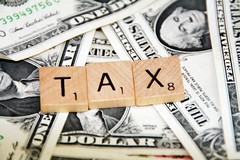Who Are the 47%?
Sep 19
September 19, 2012
kosmo - See all 763 of my articlesMitt Romney made the news when video from a private fundraiser surfaced this week. In the video, he is having a candid chat with donors, telling him that 47% of Americans will never vote for him because they are dependent on the government – asserting that these people don’t pay income taxes and feel entitled to health care, food, and housing provided by government handouts.
The 47% number gets bandied about a lot. You should ask yourself two main questions:
Is it true that 47% of people don’t pay income tax?
I addressed the topic of how many people don’t pay income taxes in greater detail in an earlier article. A big problem is that people use the terms people, households, and filers interchangeably. This is a mistake. I’ll create an example household consist of a mom and dad (married filing jointly, with tax liability), elderly grandparent living with them (minimal taxable income, no tax liability), teenage son with a part time job (minimal taxable income, no tax liability), and a ten year old and four year old. That’s one household, six people, three tax returns – only one of which has tax liability.
If you’re using statistics about filers (such as IRS data), it is very inaccurate to substitute the word “people” or “households” for “filers”. Yet, politicians and the mainstream media often do this, because it’s easier than trying to explain the nuances, even though there is a significant statistical difference. When you see these quotes, go back to the source they used and verify that they are using the correct term.
Should “the 47%ers” pay taxes?
This is a more complex question. Who are the 47% who don’t pay taxes, and why don’t they pax taxes?
The stereotype that some people are trying to construct is a family where nobody works, the kids run wild, and the parent use the welfare checks to buy Cheetos and Xbox games. Certainly this sort of abuse of the system does exist, but let’s look at other examples of people who don’t pay taxes. All of these fictional scenarios are using a very simplified tax situation of the standard deduction and exemptions, before taking any credits into account.
- The elderly – Abigail is 70 and a retired high school principal. She works ten hours each week at the local library, earning $10 per hour. She also spends twenty hours each week volunteering at various organization within her town. Other than the $5200 per year she earns at the library, the rest of her income consists of a Roth IRA (taxes paid up front), her husband’s life insurance benefits (non-taxable) and Social Security. Abigail currently doesn’t pay taxes … but she paid her fair share of taxes for decades when she was working full time.
- The young – Becky works with Abigail at the library. Becky is sixteen years old and works ten hours per week. Becky helps her parents with some of the bills and puts the rest toward college. Becky doesn’t currently pay any taxes – but she expects to pay a lot of taxes when she graduates from law school.
- The working poor – Charles and Debra, age 24, have two year old twins. Prior to the birth of the twins, both of them worked at the local grocery store. Due to high costs of day care in the community, Charles quit to stay at home with the kids until they are in school. Debra earns $12.50 per hour and is being groomed for a management position. While Charles and Debra don’t currently pay taxes, their household income will jump when Charles returns to the workforce and will continue to grow as they move up in the organization. In a few years, they’ll resume paying income tax and will do so until retirement.
- The unemployed – The factory where Edward worked shut down, resulting in hundreds of people losing their jobs. The resulting glut of a particular skill set on the market has made it very difficult to find a job, and Edward has been unable to find work. At this point, it would be difficult for Edward to move. He has strong tied to the community and he’d take a financial loss if he sold his house at the moment. Edward is no longer collecting unemployment and is burning through his nest egg and he attempts to find work. Edward is not currently paying taxes – but he’d absolutely love to return to the ranks of the tax payers.
This is not a comprehensive list.
As you can see, not everyone in the 47%ers is a “lifer”. Depending on age and/or circumstance, you may end up paying no taxes some years and paying taxes in others. Assuming that the 47%ers is a non-changing block of people is a dangerous fallacy for politicians.
 RSS
RSS



